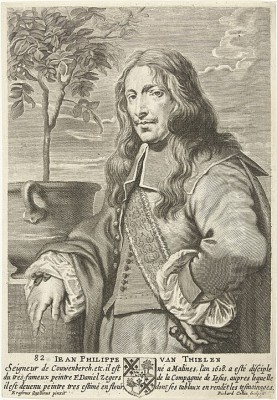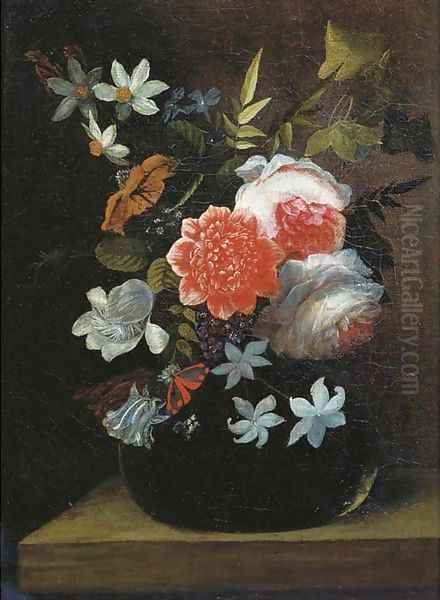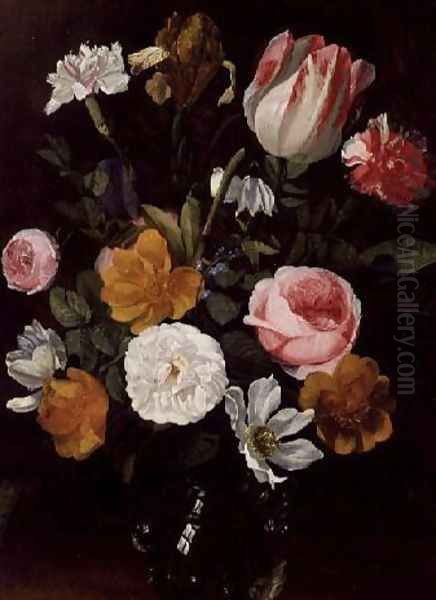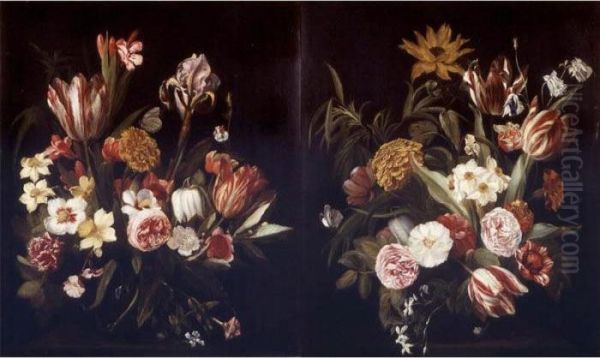
Jan Philip van Thielen stands as a distinguished figure in the rich tapestry of Flemish Baroque art, celebrated for his exquisite still-life paintings, particularly those centered on flowers and elaborate garlands. Active during the 17th century, a golden age for art in the Southern Netherlands, van Thielen carved a niche for himself with works that combined meticulous detail, vibrant color, and often, profound symbolic meaning. His art reflects both the technical prowess and the thematic concerns of his era, positioning him as a significant, if sometimes overlooked, contributor to the genre.
Early Life and Artistic Formation in Mechelen and Antwerp
Born in Mechelen in 1618 into a noble family, Jan Philip van Thielen's upbringing provided a certain social standing that was not uncommon among artists of the period, though many also came from more artisanal backgrounds. His father held a noble title, which Jan Philip himself would later inherit or adopt in his nomenclature. This aristocratic connection likely afforded him access to education and influential circles from an early age.
His initial foray into the world of art was under the tutelage of Theodoor Rombouts. Rombouts, primarily a history painter and a prominent figure in the Flemish Caravaggisti movement, would have provided van Thielen with a solid grounding in figure drawing and composition. Although van Thielen would ultimately specialize in a different genre, this early training in history painting, which often involved complex narratives and human figures, likely honed his understanding of structure and arrangement, skills transferable to the intricate compositions of still life. Rombouts himself was a respected master, known for his lively genre scenes and religious works, influenced by his time in Italy and his engagement with the dramatic lighting and realism pioneered by Caravaggio.

However, the most formative influence on van Thielen's artistic trajectory was his subsequent apprenticeship with Daniel Seghers. Seghers, a Jesuit lay brother, was one of the leading flower painters of his generation, renowned for his devotional garland paintings. These works typically featured a central religious image—often painted by another artist—encircled by a meticulously rendered wreath of flowers. Studying with Seghers immersed van Thielen in the specialized techniques of flower painting, demanding close observation of botanical specimens, a delicate touch, and a sophisticated understanding of color and texture. Seghers's studio was a hub of this particular art form, and his influence on van Thielen's style, particularly in the rendering of individual blooms and the overall harmony of his floral arrangements, is undeniable.
The Influence of Daniel Seghers and the Jesuit Connection
Daniel Seghers (1590–1661) was not merely a skilled painter; his position as a Jesuit imbued his work with a distinct spiritual dimension. Flower painting in the 17th century, especially in the devoutly Catholic Southern Netherlands, was often laden with symbolism. Flowers could represent the Virgin Mary (roses, lilies), the transience of life (vanitas), the beauty of God's creation, or specific virtues. Seghers perfected the genre of the "cartouche painting" or garland painting, where swags of flowers and fruit surrounded a central grisaille or colored image, frequently a religious scene, a portrait, or an emblem.
This genre was deeply connected to the Counter-Reformation, with the Jesuits playing a significant role in promoting art that was both aesthetically pleasing and spiritually edifying. The flowers, rendered with scientific precision, celebrated the natural world as a divine creation, while the central image provided a focus for devotion. Van Thielen absorbed this tradition directly from Seghers. His own garland paintings would continue this practice, often collaborating with other artists who would paint the central figures, a common practice in Antwerp's cooperative artistic environment. The meticulous detail and vibrant, yet harmonious, color palettes seen in Seghers's work became hallmarks of van Thielen's own floral compositions.
Mastership in the Guild of Saint Luke and Independent Career
By 1641/1642, Jan Philip van Thielen was enrolled as a master in the prestigious Guild of Saint Luke in Antwerp. Antwerp was, at this time, a major artistic center in Europe, despite economic challenges following the Dutch Revolt. The Guild regulated the art trade, maintained quality standards, and provided a framework for artists' training and careers. Becoming a master was a crucial step, allowing an artist to take on pupils, sign and sell their own works independently, and participate fully in the city's artistic life.

Once established as an independent master, van Thielen specialized almost exclusively in still lifes, particularly flower pieces and garland paintings. His works found favor with patrons who appreciated the decorative beauty and the underlying symbolism of his art. He developed a reputation for his refined technique, his ability to capture the delicate textures of petals and leaves, and his elegant compositions. While heavily indebted to Seghers, van Thielen developed his own nuances, sometimes employing slightly brighter palettes or different compositional arrangements. His dedication to this genre was such that he became one of its most recognizable practitioners in the generation following Seghers.
The Art of the Garland Painting
The garland painting, as popularized by Jan Brueghel the Elder and further developed by Daniel Seghers, was a distinctively Flemish genre. These paintings were collaborative by nature. The still-life specialist, like van Thielen, would paint the intricate floral or fruit surround, while another artist, often a figure painter, would execute the central scene. This central element could be a depiction of the Virgin and Child, a saint, a mythological scene, or even a portrait.
Van Thielen excelled in this collaborative format. His floral garlands are characterized by their lushness, botanical accuracy, and harmonious color schemes. Each flower is rendered with painstaking care, capturing its unique form, color, and texture. Common blooms in his work include roses, tulips, lilies, carnations, irises, and peonies, often interspersed with foliage and sometimes insects like butterflies or dragonflies, which added to the naturalism and could also carry symbolic weight (e.g., butterflies as symbols of resurrection or the soul).
The composition of these garlands was crucial. They needed to frame the central image effectively without overpowering it, creating a harmonious dialogue between the devotional or narrative core and the celebratory abundance of nature. Van Thielen's garlands often exhibit a sense of movement and depth, with flowers seemingly spilling forward or receding, creating a three-dimensional effect. The choice of flowers was rarely arbitrary; specific blooms could allude to the virtues of the depicted saint, the purity of the Virgin, or the Passion of Christ. For instance, roses were often associated with the Virgin Mary (the "rose without thorns") or with love, while lilies symbolized purity, and tulips, then a highly prized and exotic flower, could signify wealth or, in a vanitas context, the fleeting nature of earthly beauty.
Collaborations and Artistic Circle

Collaboration was a hallmark of the Antwerp art scene, driven by specialization and efficiency. Jan Philip van Thielen engaged in several notable collaborations, most prominently with his brother-in-law (or perhaps father-in-law, sources vary on the exact relation to his wife, Francisca de Hemelaer), the figure painter Erasmus Quellinus II. Quellinus, a student and collaborator of Peter Paul Rubens, was a versatile artist skilled in history painting and portraiture, working in a classicizing Baroque style.
Together, van Thielen and Quellinus produced numerous garland paintings where Quellinus would paint the central religious or mythological figures, and van Thielen would provide the sumptuous floral framework. A prime example is Garland of Flowers with the Holy Family and the Infant Saint John. In such works, Quellinus's calm, gracefully rendered figures provide a serene focal point, beautifully complemented by van Thielen's vibrant and meticulously detailed flowers. These collaborations were highly sought after and demonstrate the successful fusion of different artistic talents. Other figure painters he may have collaborated with include Thomas Willeboirts Bosschaert and Gonzales Coques.
Beyond direct collaborations, van Thielen operated within a vibrant artistic milieu. He was a contemporary of other still-life painters like Jan Davidsz. de Heem (though de Heem was more active in Utrecht and later Antwerp, and known for a wider range of still lifes including "pronkstilleven" or ostentatious still lifes), and younger flower painters who would continue the tradition. The towering figures of Peter Paul Rubens and Anthony van Dyck had established Antwerp's international reputation, and while van Thielen worked in a different genre, the overall artistic climate was one of high standards and innovation. He would also have been aware of the work of earlier flower painters like Jan Brueghel the Elder ("Velvet Brueghel"), Ambrosius Bosschaert the Elder, and Osias Beert, who laid the foundations for the genre in the Southern Netherlands. Clara Peeters, one of the few recognized female painters of the era, also excelled in still life, though with a broader focus than just flowers.
Van Thielen is also noted to have collaborated with Pieter Jansz. Coen on a still life depicting butterflies and a dragonfly, showcasing his versatility within the broader still-life genre, extending to the detailed depiction of insects which often carried symbolic meaning or simply demonstrated the artist's skill in capturing minute natural details. His interactions might also have included engravers like Pieter de Jode, who translated paintings into prints, thus disseminating artistic compositions to a wider audience.
Signature Styles and Evolution
An interesting aspect of van Thielen's career is the evolution of his signature, which reflected changes in his personal status and perhaps his artistic identity.
Initially, he signed his works "I.P. van Thielen."
Later, he adopted the signature "I.P. van Thielen Rigouldts." The name "Rigouldts" (or variations like Rigouts) was his mother's family name, Anne Rigouldts (or Rigouts). Adding a maternal name was not uncommon and could signify respect or acknowledge a particular lineage.
In the later part of his career, particularly from the 1660s onwards, his signature changed again to "I.P. van Thielen Heere van Cowenberch." "Heere van Couwenberch" (Lord of Couwenberch) indicates his status as a landowner or holder of a seigniorial title, reflecting his noble standing. This progression in his signature provides art historians with a useful, albeit general, tool for dating his works.
This assumption of a title underscores his noble lineage, with his father being Librecht van Thielen, Lord of Couwenberch. Jan Philip inherited this title, which he proudly incorporated into his signature, distinguishing him from artists of more humble origins and aligning him with the gentry.
Notable Works and Stylistic Hallmarks
Jan Philip van Thielen's oeuvre is characterized by its consistent quality and dedication to the floral still-life genre.
One of his most representative works, often cited, is the Garland of Flowers with the Holy Family and the Infant Saint John, a collaboration with Erasmus Quellinus II. Here, the central tondo, painted by Quellinus, depicts a tender scene of the Virgin Mary, Christ Child, Saint Joseph, and the young Saint John the Baptist. Van Thielen's contribution is the magnificent wreath of flowers that encircles this scene. The garland is a vibrant explosion of color and form, featuring roses, tulips, lilies, narcissi, and other blooms, each rendered with exquisite precision. The flowers are arranged dynamically, creating a sense of depth and abundance, and their symbolic associations (e.g., roses for Mary's love, lilies for her purity) enrich the devotional theme of the central image.
Another work, Roses, Tulips and Jasmine in a Glass with a Dragonfly and a Butterfly, showcases his skill in pure flower painting, without a central figural scene. Such pieces focus entirely on the beauty and arrangement of the flowers themselves, often set against a dark background to enhance their luminosity. The inclusion of insects like a dragonfly and a butterfly adds a touch of naturalism and further demonstrates his keen observational skills. These smaller elements also often carried vanitas connotations, reminding the viewer of the brevity of life and beauty.
His stylistic hallmarks include:
Meticulous Detail: Each petal, leaf, and insect is rendered with almost scientific accuracy.
Vibrant and Harmonious Color: He used a rich palette, balancing warm and cool tones to create visually appealing compositions. His colors are bright but retain a naturalistic quality.
Elegant Composition: Whether in complex garlands or simpler bouquets, his arrangements are balanced and graceful, often with a sense of rhythm and flow.
Smooth Finish: Van Thielen's brushwork is typically very fine and smooth, leaving little trace of individual strokes, which contributes to the illusionistic realism of his flowers.
Symbolic Depth: While visually delightful, his works often engage with the symbolic language of flowers prevalent in the 17th century, adding layers of meaning for contemporary viewers.
His style remained relatively consistent throughout his career, deeply rooted in the tradition of Seghers, but always marked by his personal refinement and elegance.
Family Life and Artistic Legacy through his Daughters
Jan Philip van Thielen married Francisca de Hemelaer. She was the sister of the wife of Erasmus Quellinus II, thus making the two artists brothers-in-law through marriage, which likely strengthened their collaborative relationship. The couple had nine children. Remarkably, three of their daughters followed in their father's artistic footsteps, becoming flower painters themselves:
Maria Theresia van Thielen (1640–1706)
Anna Maria van Thielen (born 1641)
Francisca Catharina van Thielen (born 1645)
It was not uncommon for artists to train their children in their craft, and van Thielen evidently passed on his specialized knowledge to his daughters. They worked in a style similar to their father's, producing flower still lifes that continued the family tradition. Maria Theresia, in particular, achieved a degree of recognition. The fact that three of his daughters became professional painters is noteworthy, as female artists, while present, faced more significant barriers to training and recognition in the 17th century. Their work, though less famous than their father's, contributes to the broader story of flower painting in the Flemish Baroque.
Later Years, Death, and Re-evaluation
In the 1660s, Jan Philip van Thielen moved from Antwerp back to his native Mechelen, where he continued to work. His adoption of the title "Heere van Cowenberch" in his signatures during this later period signifies his established status. He passed away in Booischot (then part of Mechelen's sphere of influence, now in Heist-op-den-Berg) in 1667.
For a period, van Thielen's work, like that of many specialized still-life painters, was somewhat overshadowed by artists with broader oeuvres or more dramatic styles. The art historian Arnold Houbraken, in his early 18th-century compilation of Dutch and Flemish painters' biographies, De groote schouburgh der Nederlantsche konstschilders en schilderessen, made an error regarding van Thielen's birth year, mistakenly recording it as 1681 instead of the correct 1618. Such inaccuracies in early art historical accounts sometimes contributed to confusion or misattribution.
However, in more recent times, there has been a growing appreciation for the specialized genres of the Baroque period, including flower painting. Scholarly research and exhibitions have shed more light on artists like Jan Philip van Thielen, recognizing their technical mastery, their role within the collaborative artistic culture of Antwerp, and their contribution to a genre that was both aesthetically rich and symbolically resonant. His works are now found in major museums worldwide, including the Prado Museum in Madrid, the Fitzwilliam Museum in Cambridge, and the Statens Museum for Kunst in Copenhagen, valued for their beauty and as prime examples of Flemish floral Baroque. His paintings are admired for their delicate execution, their vibrant celebration of nature, and their embodiment of the artistic and cultural currents of 17th-century Flanders.
Conclusion
Jan Philip van Thielen was a master of floral depiction, a dedicated specialist whose art brightened the Flemish Baroque landscape. Trained by notable figures like Theodoor Rombouts and, crucially, Daniel Seghers, he absorbed the techniques and traditions of flower and garland painting, developing a refined and elegant style. His collaborations, particularly with Erasmus Quellinus II, produced iconic examples of the garland genre, blending devotional or mythological imagery with the exuberant beauty of the natural world. Through his meticulous brushwork, harmonious compositions, and the symbolic resonance of his chosen blooms, van Thielen created works that continue to captivate viewers with their timeless appeal. As a nobleman, a respected master in the Antwerp Guild, and the patriarch of a family of artists, Jan Philip van Thielen left an indelible mark on the history of still-life painting, his legacy blooming afresh with each new generation that discovers his exquisite art.